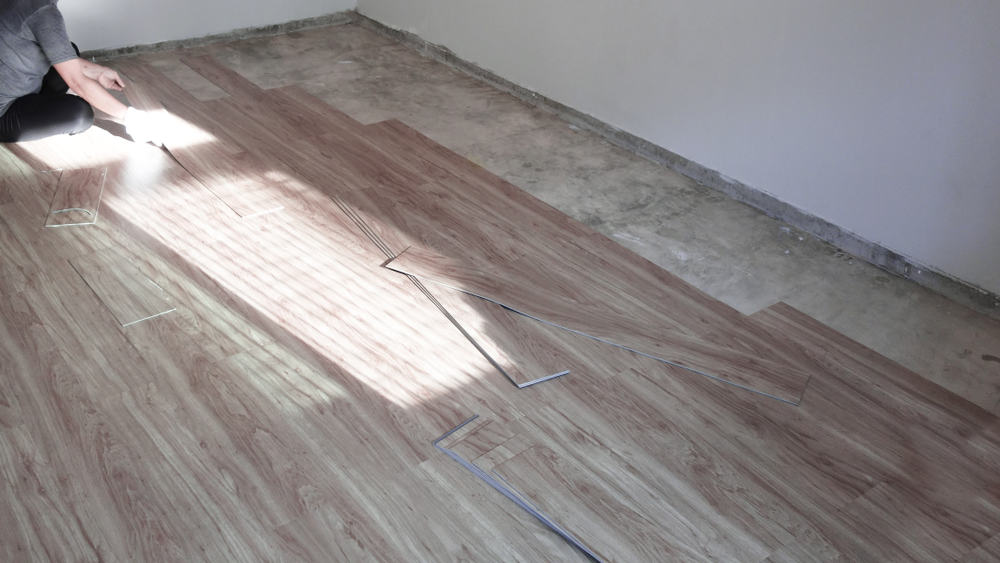Vinyl plank flooring is becoming increasingly popular, but it can still be prone to problems just like any other flooring. One of the most troublesome issues is the lifting of vinyl planks. This can be caused by various factors, but in many cases, it can be repaired without having to replace the entire floor.

Image: readytodiy.com
In this article, we will cover the causes of vinyl plank flooring lifting and provide step-by-step instructions on how to fix it. We will also discuss some preventive measures to help keep your vinyl floor looking its best.
What Causes Vinyl Plank Flooring to Lift?
There are many causes for vinyl plank flooring to lift, including:
- Improper installation: Improper installation can cause the planks not to be properly secured, allowing them to lift over time, especially during extreme temperature fluctuations.
- Moisture: Vinyl planks can expand and contract based on moisture and temperature changes. Excessive moisture can cause the planks to swell and lift.
- Subfloor issues: Subfloor problems, such as unevenness or lack of proper support, can put stress on the vinyl planks and cause them to lift.
- Temperature fluctuations: Extreme temperature variations can cause the vinyl planks to expand and contract rapidly, potentially leading to buckling or lifting.
How to Fix Vinyl Plank Flooring That Is Lifting
If you find that your vinyl plank flooring is lifting, it’s important to repair it as soon as possible. Here’s a step-by-step guide on how to fix lifting vinyl plank flooring:
- Identify the cause: Determine the cause of the lifting. Check for moisture, uneven subfloor, or improper installation.
- Remove the affected planks: Carefully remove the lifted planks. Avoid damaging the planks or the subfloor.
- Prepare the subfloor: Inspect the subfloor for unevenness or moisture. Level the subfloor if necessary and address any moisture issues.
- Apply adhesive: Spread a thin layer of adhesive to both the subfloor and the back of the vinyl plank. Ensure the adhesive is compatible with vinyl flooring.
- Reinstall the planks: Place the vinyl planks back into position and firmly press them into place. Use a roller or tapping block to ensure they are properly adhered.
- Allow the adhesive to dry: Follow the manufacturer’s instructions for drying time. Allow the adhesive to fully set before walking on the repaired area.
Tips and Expert Advice
Here are some tips and expert advice for preventing and fixing vinyl plank flooring that is lifting:
- Acclimate the planks before installation. Allow the vinyl planks to acclimate to the temperature and humidity of the room before installing them.
- Install the planks according to the manufacturer’s instructions. This includes using the proper adhesive and spacing.
- Avoid installing vinyl planks in areas with excessive moisture or direct sunlight.
- Use a moisture barrier under the vinyl planks to protect them from moisture damage.
- Inspect the floor regularly for any signs of lifting or damage and address it promptly.

Image: jjvs.org
Frequently Asked Questions
- Q: Why is my vinyl plank flooring lifting at the edges?
A: Lifting at the edges can indicate improper installation or moisture damage. - Q: Can I repair lifted vinyl plank flooring myself?
A: Yes, it is possible to repair lifted vinyl plank flooring with the right tools and materials. - Q: How do I prevent vinyl plank flooring from lifting?
A: Proper installation, moisture control, and regular maintenance can help prevent lifting.
How To Fix Vinyl Plank Flooring That Is Lifting
Conclusion
Vinyl plank flooring is a popular and durable option for many homeowners, but it can be prone to lifting if not installed or maintained properly.
If your vinyl plank flooring is lifting, don’t panic! By following the steps and tips outlined in this article, you can repair the affected planks and keep your floor looking its best. Remember, regular inspection and proper maintenance are key to preventing future problems.
Is there anything else you’d like to know about fixing vinyl plank flooring that is lifting?